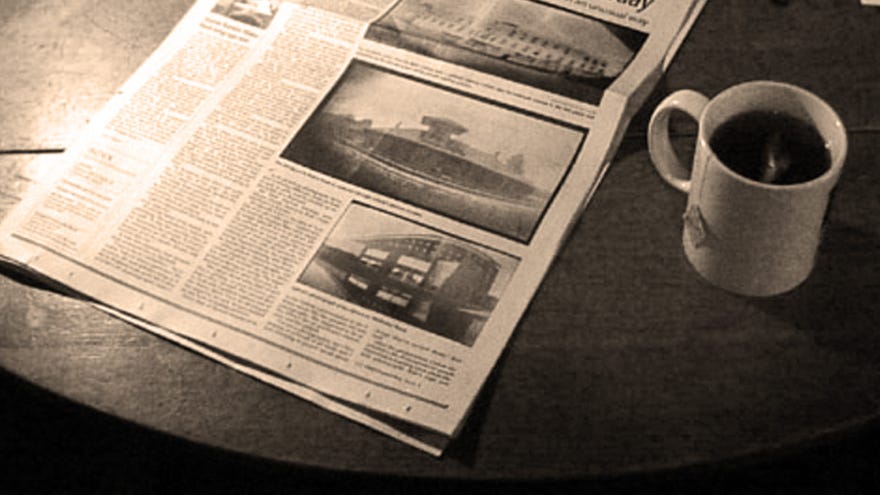The Sunday Papers
Read more
Sundays are for questioning the fundamental tenets of reality, thanks to a real good book called Schlid's Ladder by Greg Egan. Here's the best writing about videogames from the past week.
Daniel Mallory Ortberg's marvellous embodiment of gooseness is required reading.
I am the horrible creeping bag of sound that is the most worst to you! I will use my beak to mischief you and I will press B. I wobble my snake-front-body and I waggle my bag-back-body and they meet in the middle to plan a bad idea to upset you. I flap back and forth my business rear for balancing and I snapple-pap my feet all up and down the town for terrible reasons, and you don’t like it. I am the goose and you are the miserable boy with no honk. I invented my body and it was the best idea.
Seva, for his blog "Historian On Games", examined which videogames we should preserve and why. One of his central arguments is that we need to be OK with the fact that large swathes of videogames are ultimately going to vanish, even if our impulse is to decry their loss. Nothing lasts forever, as Seva says, but that's fine - and doesn't mean we shouldn't think carefully about the cultural artifacts we do preserve.
Which brings me to the crux of the matter. From my admittedly outsider perspective, it seems that game preservation efforts risk being trapped in an impossible quest for cultural immortality. Keeping in mind my previous point regarding labour, I assert that games are, inherently, fleeting things. Like other pieces of art or cultural objects, games represent memories, they connect to individual and collective pasts, our experience of them is, more than anything, nostalgic.
For Polygon, Jennifer Scheurle explained how she and designers in general approach difficulty in games. It's genuinely elucidating to hear this described from the other side of the fence.
At the core of the difference between how game designers and players speak about difficulty is the fact that we discuss it in terms of skill progression. All difficulty design is essentially that: crafting how players will learn, apply skills, and progress through challenges.
Game designers don’t actually talk that much about difficulty; we talk about things like progression systems and mental load. None of these things are strictly questions of “difficult” versus “easy” — they’re more about how we guide players to greater competency, and what that journey should be like, ideally.
Finally, someone in the games media has called out Birmingham New Street Station for the horrible tangled mess it is. Malindy Hetfeld's Eurogamer article about why this makes New Street a good place to set a videogame made me smile, and not just because I've spent an inordinate amount of time there.
Nothing at New Street provides you with a straight line from A to B. An online commenter on a review portal went so far as to describe the station as a place "where ticket barriers and exits pop up and vanish at will" and another made a similar observation, comparing it to the vanishing steps at Hogwarts. How marvellous would that be to take a place you know and recognise and use it as your adversary, not just a setting. To conquer a supernatural version of a thoroughly mundane train station in a game could be a great way to see a place that I now feel nothing but anxiety towards with fresh eyes.
On Kotaku, I enjoyed Nathan Grayson's interview with Supergiant studio director Amir Rao and writer/designer Greg Kasavin. The Bastion developers are relentlessly modest. Supergiant's sustainable work culture sounds both incredible and imitable, but that modesty does make it easy to gloss over the way they also owe much of their success to being stupendously talented.
The studio has made changes over time to ensure that everybody takes care of themselves. For example, Supergiant began as a company with unlimited time off. But, Rao explained, this created an “invisible pressure” to never stop working, because developers always had endless vacation time in their back pockets. These days, Supergiant still offers unlimited time off, but employees are required to take at least 20 days off per year. “This is us saving us from ourselves,” Rao said. “That changes our psychology to ‘How do I spend this minimum? Where do I put it? Am I doing a summer break, or am I doing every Friday for a little while?’”
Matt Simon's Wired article about that Boston Dynamics dog is interesting, largely because (as Mike Cook pointed out on Twitter) it inadvertently illustrates the lack of viable applications for the tech in its current state. I want wild robot dogs as much as the next person, but properly useful ones are clearly very far away and this serves as a nice reality check.
But in my visit to that Boston construction site, BD was emphasizing a different use for Spot: as a sort of patrolbot that can continuously inspect a space. On a typical job site, a manager might be able to peruse and document the whole operation once a week to make sure all the components are coming into place properly, and that crews aren’t, say, running a duct where there’s supposed to be a supporting column. But if you loaded out Spot with a 360 camera, it could do the rounds every night, because once it builds an initial 3D map of the environment, during each subsequent visit it can detect changes.
Music this week is Workin's Too Hard by Rayna Gellert.

